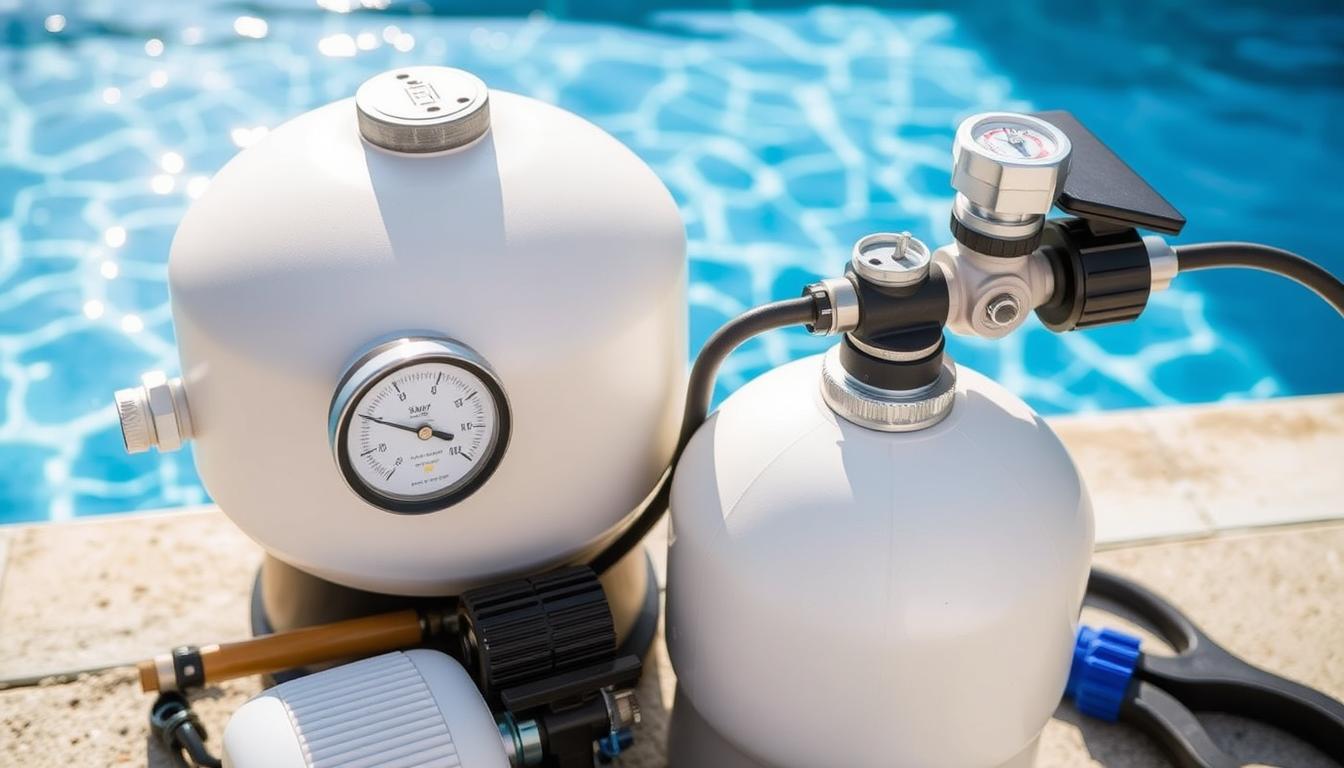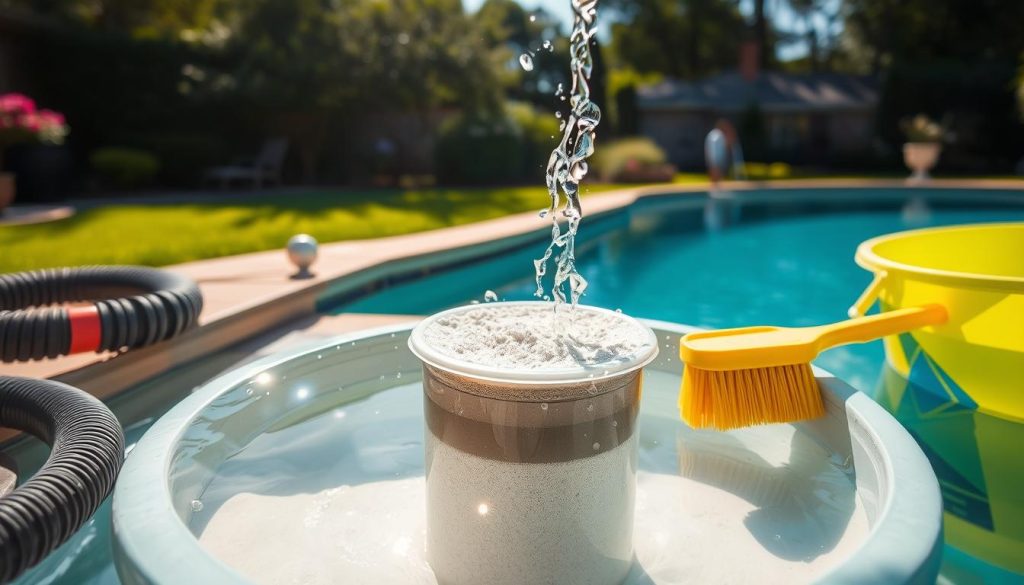
Is your pool looking cloudy? It might be time to clean your sand filter. Don’t worry! Our guide will help you get crystal-clear water again.
We’ll show you how to maintain your pool’s sand filter effectively. You’ll be swimming in pristine water before you know it.
Sand filters are crucial for keeping your pool clean. They can catch tiny particles, making your water healthy and inviting. However, these filters need regular care to work well.
Regular backwashing and occasional sand replacement are key. These steps ensure your filter keeps performing at its best.
Our guide covers everything from backwashing to troubleshooting common issues. You’ll learn how to clean your pool sand filter like a pro.
Ready to make your pool sparkle? Let’s get started on restoring your sand filter!
Understanding the Importance of a Clean Sand Filter
A clean sand filter is vital for a healthy, safe pool. It removes dirt and contaminants from the water. A well-maintained filter ensures crystal-clear water and extends the system’s life.
Maintaining Optimal Pool Water Clarity
A clean sand filter traps particles, keeping your pool water clear. Over time, debris can clog the filter, reducing its efficiency. This can lead to cloudy water, which is unappealing and potentially unhealthy.
Follow a regular cleaning schedule for your sand filter. Backwash when the pressure gauge reads 8-10 psi above normal. Replace the sand every 5-7 years for a sparkling clean pool.
Preventing Algae Growth and Ensuring Healthy Swimming Conditions
A clean filter prevents algae growth by removing organic matter. This deprives algae of the nutrients they need to thrive. Regular cleaning helps maintain balanced pool chemistry.
A well-maintained filter creates a healthy swimming environment. It prevents imbalances that can irritate swimmers’ eyes and skin. Keep your filter clean for safe and enjoyable swimming.
Did you know? Running your pool pump for 8-12 hours a day during the swimming season is recommended for proper circulation and filtration.
Extending the Lifespan of Your Pool Filter System
A clean sand filter benefits water quality and extends your filtration system’s life. A clogged filter strains your pool pump, increasing energy use and risking equipment failure.
Follow cleaning tips like checking the pressure gauge and backwashing when needed. Use quality cleaning products to keep your system running smoothly. This approach can prevent costly repairs and premature equipment replacement.
| Filter Type | Cleaning Frequency | Replacement Schedule |
|---|---|---|
| Sand Filter | Backwash when pressure is 8-10 psi above normal | Replace sand every 5-7 years |
| Cartridge Filter | Remove and hose off cartridge every 1-2 months | Replace cartridge every 1-2 years |
| DE Filter | Backwash when pressure rises 8-10 psi above normal | Replace DE powder after each backwash |
How to Clean Sand Filter for Pool
A clean sand filter ensures crystal-clear pool water and optimal filtration. This guide will help you clean your pool’s sand filter effectively. We’ll cover the process from gathering tools to inspecting the multiport valve and pressure gauge.
Gathering Necessary Tools and Materials
Prepare all required tools before starting. You’ll need a backwash hose, clean bucket, and gloves. Ensure access to a water source and suitable drainage area for backwash water.
Turning Off the Pump and Relieving System Pressure
Start by turning off the pool pump. This stops water circulation during cleaning. Locate the air relief valve on the filter tank.
Open the valve to release built-up pressure. This step prevents potential damage to filter components.

Backwashing the Sand Filter
Set the multiport valve to “backwash” position. Attach the backwash hose to the valve’s port. Place the hose’s other end in a drainage area.
Turn the pump on to reverse water flow through the filter. This flushes out trapped debris. Continue until the sight glass water runs clear.
Rinsing the Filter and Settling the Sand Bed
Turn the pump off after backwashing. Set the multiport valve to “rinse” and restart the pump. This settles the sand bed and removes remaining debris.
Run the rinse cycle for 30 seconds to 1 minute. Stop when the sight glass water appears clear.
Inspecting the Multiport Valve and Pressure Gauge
Check the multiport valve and pressure gauge for damage. Ensure the valve moves smoothly between positions. Verify the pressure gauge reads within normal range.
Address any issues promptly to maintain filter efficiency. This helps extend your pool filter system’s lifespan.
Regular sand filter cleaning is crucial for clear water and a healthy pool. Follow these steps to maintain your filter system. Enjoy a sparkling clean pool all season long.
Establishing a Regular Sand Filter Cleaning Schedule
A consistent pool sand filter cleaning schedule is crucial for optimal water quality. The cleaning frequency depends on pool usage, environment, and filter size. Backwash the sand filter when the pressure gauge shows an 8-10 psi increase above normal.
For most residential pools, backwashing typically happens every couple of weeks. We suggest a thorough cleaning of the sand filter annually. This involves removing the sand and checking for wear or contamination.
Replace the sand if it looks worn or dirty. Sand in pool filters should be replaced every five to seven years. This ensures the best performance and water clarity.
A regular cleaning schedule extends the filter system’s life. It also provides a clean, healthy swimming environment all season. Watch the pressure gauge and water quality to determine when to backwash or clean thoroughly.
Proper maintenance helps the sand filter remove debris and contaminants effectively. This results in crystal-clear pool water for years to come.







